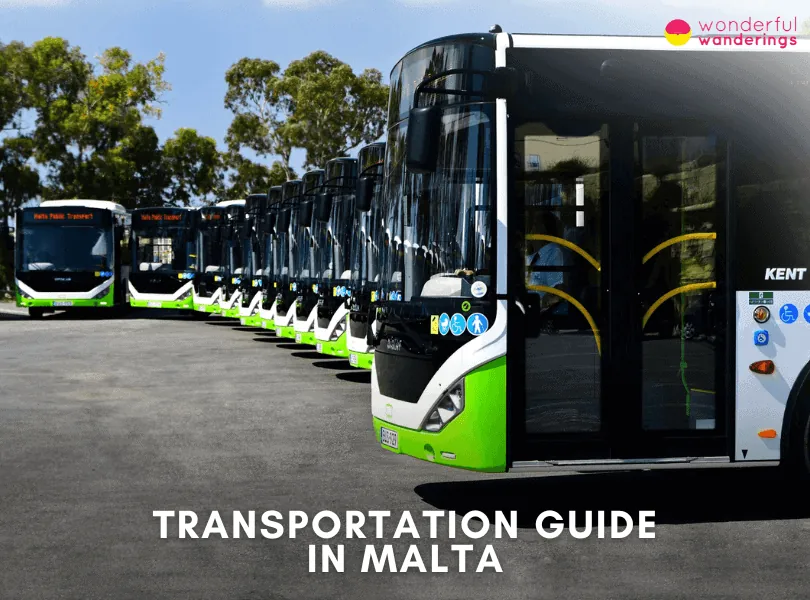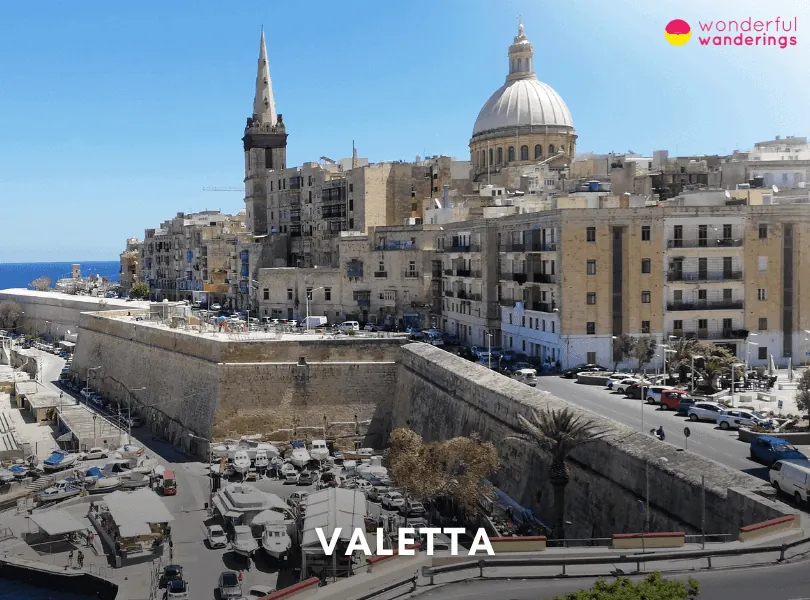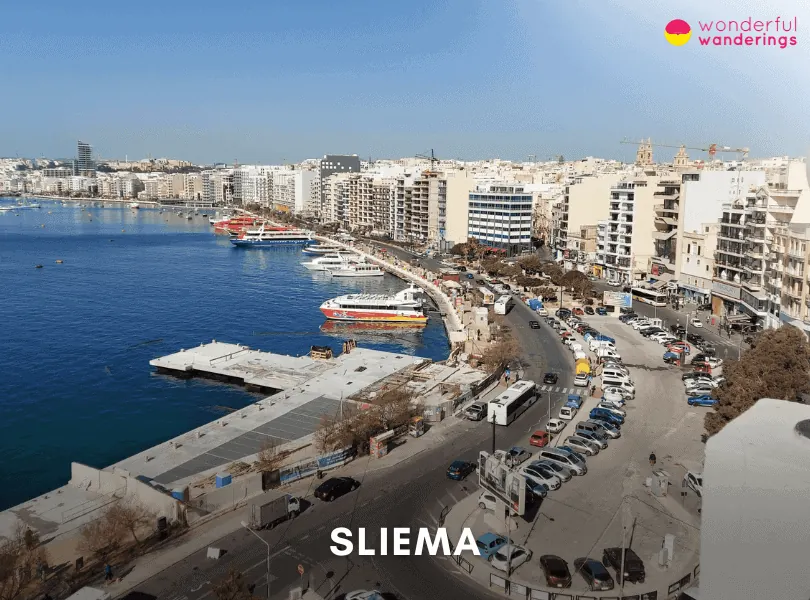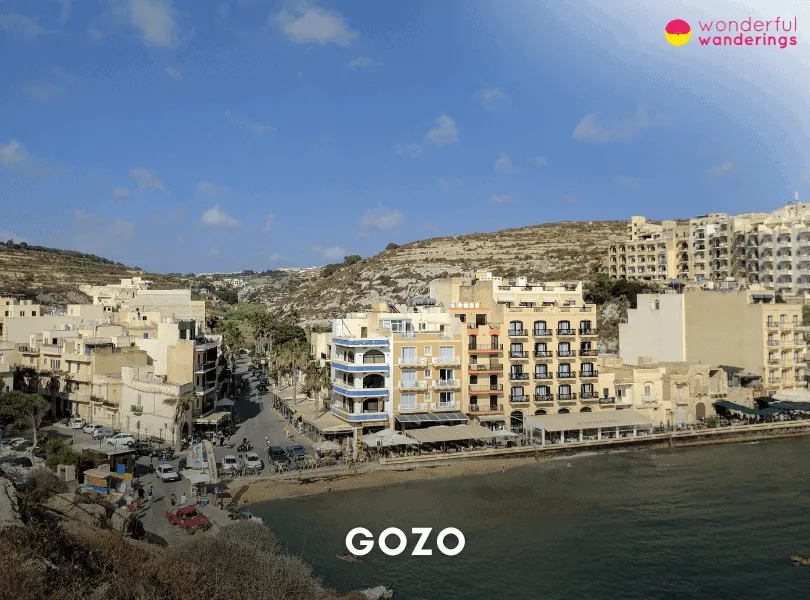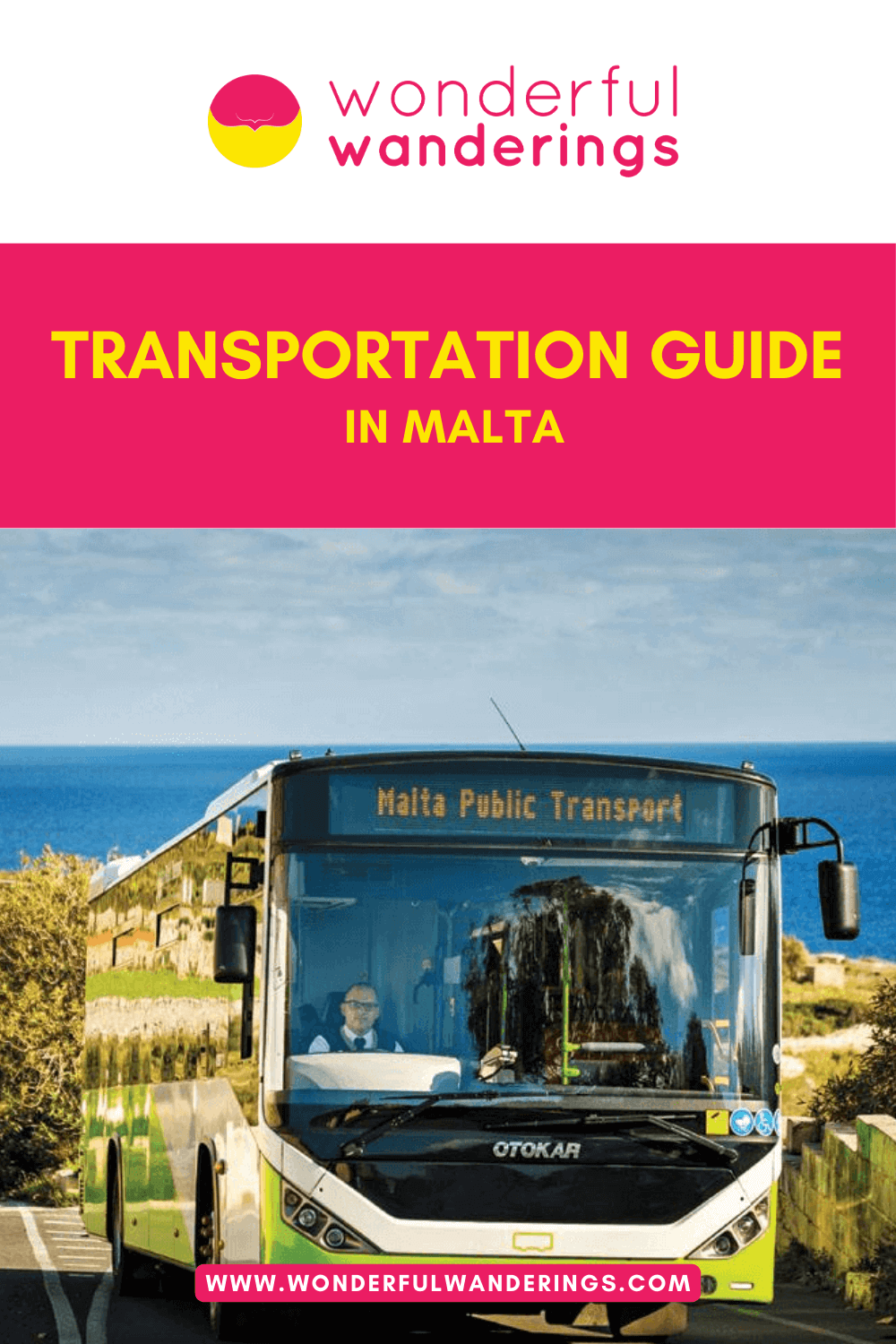Malta, an archipelago in the Mediterranean, is south of Sicily and accessible through various transport modes. The leading travel options include flights to Malta International Airport, connecting to major European cities and sea routes from Italian ports like Sicily and Naples. Once in Malta, travelers have several choices for getting around. From Malta International Airport, options include taxis, buses and rental cars. Taxis offer a direct, although more costly, route to destinations, with metered fares starting at €3.49 ($4, £3) plus €0.79 ($0.90, £0.70) per kilometer. The extensive bus network, a more economical choice, connects the airport to numerous locations across Malta and Gozo, with tickets €2 ($2.30, £1.80). Rental cars provide the most excellent flexibility for exploring, with rates starting at €35 ($40, £30) per day, ideal for visiting remote areas and beaches. Malta’s compact size makes driving manageable, but visitors should be cautious of narrow, winding roads and local driving habits. The rental cars available at the airport come with basic insurance, but additional coverage is recommended. Ferries are essential in Malta, particularly for travel between the main islands and the more rural Gozo, best explored by rental cars or scooters. The ferry system offers a reliable and scenic travel option, complementing the extensive bus network. Malta offers a variety of transportation options to suit different preferences and needs.
Contents
- Where is Malta located?
- How to Get to Malta?
- What Type of Transportation can you Choose To get Around Malta from the Airport?
- Why Riding a Bus in Malta is Economical and Environmentally Friendly?
- Why You Should Consider Taxi Rides for Short Trips in Malta?
- Why Rental Cars are the Best Option to Go Around Malta, Especially for the Family?
- Why should you Try to Take the Ferry in Malta?
- Who would Consider a Bicycle as a Transporation to Go Around Malta?
- What are the Big Towns in Malta?
- When is the Best Time to Visit Malta?
- How Is Driving in Malta?
- Can you rent a car in Malta?
Where is Malta located?
Malta is an archipelago located in the Mediterranean Sea, south of Sicily. It is located 80 kilometers (50 miles) south of Sicily, 284 kilometers (176 miles) east of Tunisia and 333 kilometers (207 miles) north of Libya. Malta comprises three main islands – Malta, Gozo and Comino – along with several uninhabited tiny islands. The Maltese islands cover 316 square kilometers (122 square miles) in land area, making Malta one of the world’s smallest countries. Malta lies on the Malta plateau, which extends from North Africa. Low hills characterize the landscape with terraced fields, valleys and small bays indented into rocky coasts with cliffs, caves and sandy beaches. Due to its location in the Mediterranean Sea, Malta has a Mediterranean climate with hot, dry summers, mild winters and little rainfall. The main island of Malta is just 27 kilometers (17 miles) long and 14.5 kilometers (9 miles) wide at its widest point. Locals typically drive cars or motorbikes to get around, often commuting from their homes in villages to the capital, Valletta, for work. Public buses are also a trendy way for residents to get around Malta. Due to the proximity of all destinations given Malta’s small size, travel by ferry between the islands is also common for locals. The ferry trip from Malta to Gozo takes just 25 minutes.
How to Get to Malta?
There are 3 main ways to get to Malta. Firstly, the most common way visitors travel to Malta is by airplane. Malta has one international airport, Malta International Airport, which handles connections to and from major European cities. Many budget airlines like Ryanair and Air Malta offer cheap flights to Malta from cities like London, Paris, Frankfurt and Rome. The flight time from most European cities is 2 to 3 hours. Malta’s airport receives over 6 million passengers each year. Secondly, travelers can reach Malta by sea. Regular ferry and catamaran routes run from Italian cities like Sicily, Naples and Pozzallo to the port of Valletta City in Malta. The ferry from Pozzallo takes 90 minutes, while ferries from farther Italian ports can take 4 to 8 hours to reach Malta. Taking the ferry is a popular route for visitors from Italy and Sicily looking to explore Malta. Lastly, although trains do not run directly to Malta, visitors can take train and ferry connections from Italy. One can take a train from Rome to the Italian port city of Pozzallo before catching the 90-minute ferry across the sea to Malta. Trains alone cannot directly access Malta, combining the rail network of Italy with ferries makes for easy connections into Valletta harbor for tourists.
How Many Airports are there in Malta?
There is only one airport in Malta called Malta International Airport. Malta International Airport has one passenger terminal and a single asphalt runway over 3 kilometers (1.86 miles) long. The airport served over 6 million passengers on flights to and from over 100 destinations throughout Europe and the Middle East.
The best transportation options available for visitors to ride from the airports in Malta include taxis, buses and rental cars. Firstly, car rental is one of the best and most popular options for getting around Malta after arriving at the airport. Major rental agencies like Avis, Hertz and Europcar conveniently have desks inside the main arrivals terminal. Travelers can book compact cars online beforehand or directly at a counter. Small vehicles like Fiat Pandas or Toyota Aygos can be rented for €35 ($40, £30) daily. Secondly, taking white taxis from the airport arrival taxi stand is a seamless transportation option into Valletta or other cities. Licensed Maltese cab drivers adorn their old-school vehicles with fresh flowers and lace doilies. The initial taxi meter rate in Malta is €3.49 ($4, £3), plus €0.79 ($0.90, £0.70) per kilometer, making the 20-kilometer (12 miles) trip to the capital Valletta €20 ($23, £18). Taxis can also be booked over the phone or via apps like Bolt for convenience. Lastly, Malta’s extensive public bus system connects the airport everywhere across Malta and Gozo, stopping just outside the terminal. Routes like the X4 offer express connections to popular spots like Sliema and Valletta 4 times an hour, with tickets costing just €2 ($2.30, £1.80). The scenic route between Valletta and the Gozo ferry also stops at the airport.
What Type of Transportation can you Choose To get Around Malta from the Airport?
Listed below are the types of transportation that visitors can choose to get around Malta from the Airport.
- Buses. Buses are the cheapest way to get around Malta, with a single ticket costing just €1.50 ($1.70, £1.30) during winter or €2 ($2.30, £1.80) in summer. Tickets can be purchased from the driver in cash. The bus network in Malta is pervasive, connecting all towns and villages on the island at least 2-3 times per hour, even reaching remote destinations like Ċirkewwa for the Gozo ferry. Bus routes X4 and X5 offer express connections to popular spots like Sliema, St. Julians and Valletta 4 times an hour. The X4 stops outside the airport terminal building, providing transfers every 30 minutes.
- Taxis. A large taxi stand outside the airport terminal offers 24/7 metered cab service across Malta. Taxis are all painted white and drivers take great pride in decorating their old-school vehicles. The initial meter rate is €3.49 ($4, £3), plus €0.79 ($0.90, £0.70) per kilometer, making the 20-kilometer (3 miles) trip to the capital Valletta €20 ($23, £18). Taxis can also be booked quickly via apps like Bolt. Cab drivers don’t always speak English fluently, so communicating your destination can pose challenges compared to just taking the direct airport bus. Always carry some cash on hand, as some drivers resent taking cards for short rides.
- Rental Cars. Renting a car from one of the many significant agencies inside Malta International Airport provides the optimal flexibility to independently beach-hop or explore off-the-beaten rural villages across Malta, Gozo and Comino entirely on your schedule. Small cars like Toyota Aygos can be rented for €35 ($40, £30) daily. Gas stations are also limited outside main hubs and parking is difficult, requiring parallel precision between partially pulled-in vehicles. Tolls, surcharges and deductibles also quickly inflate daily rates.
- Ferries. Ferries conveniently connect Ċirkewwa Harbour on Malta to Mgarr Harbor on Gozo. The journey takes just 25 minutes, operating at least hourly most days. There are no direct ferry connections from the airport itself. Visitors first need to take a bus to Ċirkewwa, 25 minutes from the airport. Ferries only reach Gozo and Comino, leaving much more limited transportation than Malta’s extensive bus network. Ferries serve as a complement rather than a substitute for getting around Malta.
Why Riding a Bus in Malta is Economical and Environmentally Friendly?
There are three main reasons why bus riding in Malta is economical and environmentally friendly. Firstly, buses are the most affordable and economical way to travel around Malta. A tallying card can be loaded, allowing tap-on access to Malta’s extensive bus network starting from just €1.50 ($1.70, £1.30) per 90-minute trip in winter or €2 ($2.30, £1.80) per trip in summer months. Even tourists paying cash can ride routes connecting any village or coastal area on the islands with a single ticket, never costing over €3 ($3.40, £2.70). The year-long Explore Card delivers unlimited nationwide access for €39 ($45, £35). Secondly, buses minimize the high costs associated with other transport like taxis or rental cars that quickly inflate vacation budgets. Buses eliminate expenses, keeping money in visitor’s pockets to boost Malta’s tourism economy. Lastly, choosing Malta’s energy-efficient buses over taxis and rental cars reduces greenhouse emissions from transport. Buses service high passenger volumes using less fuel per capita than individualized alternatives filled with solo riders. Bus-centric travel patterns directly support the Maltese government’s goal of achieving carbon-neutral public transport by 2050 under its Transport Master Plan 2025.
Why You Should Consider Taxi Rides for Short Trips in Malta?
Visitors should consider taxi rides for short trips in Malta as they are affordable, eliminate hassle routes and save time and effort. Firstly, taxis in Malta provide an affordable and convenient mode of transportation for quick, short-distance trips between nearby towns and villages. The initial meter rate is a reasonable €3.49 ($4, £3), plus €0.79 ($0.90, £0.70) per kilometer traveled. This means a ride from Sliema to the capital, Valletta, would cost €7.50 ($9, £7), comparable to buying two bus tickets but with the door-to-door ease of a private cab. Making frequent short hops between neighboring destinations via taxi is budget-friendly. Secondly, taxis eliminate the hassle of learning routes and timetables associated with Malta’s confusing bus system. Locals complain even long-time residents struggle to master the islands’ unorganized bus schedules and indistinguishable station names. Attempting multiple stops often requires identifying specific bus numbers at vaguely named stops. Lastly, taxis provide practical advantages over buses for riders. Transporting luggage and gear between accommodations poses difficulties on crowded Maltese buses for families and solo travelers. Parents juggle collapsing strollers while weekday commuters squeeze past with briefcases. Taxis easily accommodate travelers with cargo plus offer quicker point-to-point transit without packed public transportation, which is especially appealing after long flights.
Why Rental Cars are the Best Option to Go Around Malta, Especially for the Family?
Rental cars are the best option to go around Malta, especially for the family, as they offer convenience, flexibility, safety and security reassurances. Firstly, rental cars provide convenience and flexibility for families to explore Malta at their own pace easily. A rental car eliminates relying on public transportation schedules and lengthy transfers between sites, allowing families to optimize their time and visit more attractions efficiently. This is especially useful when traveling with young children. Rental cars also provide access to remote areas and scenic countryside not easily reached by public transport, so families can discover hidden gems across the islands. Secondly, rental cars ensure a comfortable travel experience. They offer ample space to accommodate families and luggage so everyone can spread out. Features like GPS, car seats, climate control and charging ports enhance comfort. Renting a larger vehicle like a minivan or SUV provides even more passenger and cargo room for family road trips. Thirdly, rental cars offer safety and security reassurances. Reputable agencies ensure their fleets are well-maintained with essential safety features like working seatbelts and child car seats available. Many now have integrated technology like GPS tracking for additional peace of mind. Rental cars also mitigate safety issues with public transportation, allowing families to stay together.
Lastly, rental cars give families the flexibility to control their budgets. The daily rental rate might seem expensive, but having a private vehicle avoids costs like taxis, buses or multiple transfers, which can add up. Rental cars allow families to shop for budget accommodation outside cities, independent of public transport to critical sites. The convenience and tailored experience a rental car facilitates make it a better value.
Why should you Try to Take the Ferry in Malta?
There are four primary reasons why visitors should try to take the ferry in Malta. Firstly, the ferry provides a convenient way to travel between the main islands of Malta, Gozo and Comino. The regular ferry services allow visitors to easily visit the attractions of Gozo, explore the famous Blue Lagoon on Comino or make day trips back and forth from the capital, Valletta, without needing a car. Secondly, the ferry is often cheaper and more cost-effective than relying solely on other transport options like taxis or rental cars, especially for budget-conscious travelers. Return ferry tickets start from €5 ($5.75, £4.60) and discounts are available for students, children and senior citizens. Traveling by ferry also avoids fuel and parking costs associated with driving. Thirdly, the ferry timetables are frequent and reliable, with sailings operating every 30-45 minutes on critical routes. This allows flexibility to come and go at its own pace. The fast catamaran ferries complete most crossings in under an hour. Lastly, ferry travel will enable visitors to avoid traffic congestion in peak seasons. It is often quicker than driving between the islands. Ferries have ample room for luggage and some routes allow vehicles if you rent a car for part of the trip.
Who would Consider a Bicycle as a Transporation to Go Around Malta?
Individuals who want to explore leisurely, desire transportation and cultural immersion and are health-conscious would consider bicycles as a means of transportation. Firstly, cycling around Malta would appeal most to tourists and visitors who want to explore different areas of the islands leisurely, taking in scenic views and stopping at points of interest. Malta’s mild climate, small size and relatively flat terrain make it ideal for recreational cycling. Tour companies offer bicycle tours catered to tourists. Secondly, some residents are adopting cycling for their daily commute, especially for short trips that can be covered quickly by bike. Commuters are attracted to cycling’s flexibility, reliability for short distances, exercise benefits and the lack of parking hassles compared to cars. Malta’s roads are generally not designed with cyclist safety as a priority, so commuters use quieter back streets and plan routes to avoid heavy traffic when possible. Electric bikes are growing in popularity among commuters. Thirdly, cycling advocates and activists are pushing for better cycling infrastructure and routes, hoping to transform Malta into a genuinely bike-friendly country. Groups like Rota criticize the lack of continuous, protected bike lanes and argue that better facilities are needed to make cycling safe and accessible for transportation. Some progress has been made recently with new bike lanes and the promotion of bike-sharing programs, but advocates say there is still a long way to go before cycling is fully integrated as a transportation option. Lastly, health-conscious Maltese concerned about the nation’s high obesity rates see cycling as a way to build physical activity into their daily routine. Parents are also putting their kids on bikes more to promote healthy habits.
What are the Big Towns in Malta?
The big towns in Malta are Valletta, Sliema and Gozo. Valletta, Malta’s capital, is recognized as a UNESCO World Heritage Site. It features Baroque architecture and is easily accessible from Malta International Airport. The city’s compact layout makes it ideal for walking or taking ferries for waterfront travel. Sliema, a former fishing village, has become a tourist hotspot along Malta’s northeast coast. Walking is the preferred way to experience Sliema’s scenic views. Gozo, Malta’s sister island, offers a serene, rural escape. Accessible by a 25-minute ferry from Malta, it is known for traditional crafts and seaside villages. Gozo is explored best by rental cars or scooters, with services available in key towns.
1. Valetta
Valletta is Malta’s capital city and cultural heart, built on the Sceberras Peninsula, which juts into the Grand Harbour on the country’s northeast coast. Founded in 1566, Valletta occupies a minuscule 0.8 square kilometer (0.3 square miles) area, given its length of just 1 kilometer (0.6 miles) and width of 600 meters (0.4 miles). Valletta has served as Malta’s administrative hub since the 16th century and today, it houses the nation’s supreme governmental bodies and central business district. Its fortified bastion walls, monumental churches and palatial architecture retain historical significance, evidenced by its status as a UNESCO World Heritage Site.
Valletta sits just 11 kilometers (7 miles) from Malta International Airport. It can be reached in 20 minutes via rental car or taxi, with the trip costing €20 ($23, £18) by cab. Two express bus routes, X4 and X5, offer direct frequent service between the airport and Valletta’s city gate terminal every 30 minutes for only €2 ($2.30, £1.80), which takes 25 minutes. Visitors can walk the entire old fortified capital in well under an hour. Top attractions clustered together include St. John’s Co-Cathedral, the Grandmaster’s Palace and Upper Barrakka Gardens overlooking the harbor, which is easily explorable on foot. For those not keen to wander far, cheap ferries connecting Valletta’s waterfront areas cost only €2 ($2.30, £1.80).
2. Sliema
Sliema is a large town on a narrow peninsula along Malta’s northeast coast. It emerged relatively recently as the island’s pre-eminent hub for leisure and entertainment compared to the historic capital, Valletta. Once a small, quiet fishing village on the outskirts of larger cities, Sliema expanded into Malta’s leading coastal resort area thanks to continuous development that filled the adjoining space towards neighboring St. Julian’s. Sliema and St. Julian’s effectively merge to form one urban coastal stretch dubbed the nation’s “Leisure Peninsula”. Combined, they occupy over 6 kilometers (4 miles) of scenic shoreline and house some 36,000 residents across modern Mediterranean-style apartment blocks and upscale villa complexes.
Sliema offers elite shopping at the massive retail complex The Point, luxury boutiques on the aptly named Tower Road and endless seaside cafes lining its beach promenade to rival any European resort destination. It is 8 kilometers (5 miles) from Malta International Airport. Sliema is conveniently accessible by the X4 and X5 express buses, which depart for Sliema every 30 minutes, completing the 15-minute trip for only €2 ($2.30, £1.80). Taxis cover the short distance in 10 minutes for roughly €15 ($17, £13). Most attractions cluster along Sliema’s scenic coastal Tigne and Qui-si-Sana stretches.
3. Gozo
Gozo is the sister island of Malta located just 5 kilometers (3 miles) north across the sea, though it feels worlds apart from its busy neighboring island. Accessible via 25-minute ferry rides operating continuously between Ċirkewwa Harbour on Malta to Mgarr Harbour on Gozo. Gozo is home to only 32,000 residents focused mostly on fishing, farming and traditional crafts, comparatively untouched by mainstream tourism. It has coastal gems like Ramla Bay and scenic inland hilltop villages like Gharb, Gozo moves at a relaxed pace, intentionally retaining deep ties to local traditions best experienced by visitors staying a few nights rather than brief day trips.
Gozo’s remoteness means most tourists explore via organized tour buses, rental cars and scooters available for €30 ($35, £27) per day from main visitor hubs on the island, like the capital, Victoria, set on a hilltop citadel. The popular seaside village Marsalforn has restaurants stretching around a sheltered bay holding colorful fishing boats. Gozo’s location is just 15 kilometers (9 miles) beyond Malta International Airport and factoring in the quick 25-minute Gozo Channel ferry crossing also makes it simple to incorporate some days on this island either at the start or tail-end of a Maltese getaway.
When is the Best Time to Visit Malta?
The best time to visit Malta is during the spring and fall shoulder seasons to enjoy pleasant weather and fewer crowds. The optimal window spans from April to June and September to early November. Spring boasts average high temperatures of 20°C (68°F), allowing comfortable sightseeing days. Places like the Blue Grotto sea caverns and Valletta markets come alive minus summertime intensity. Hotel rates before peak season offer up to 50% savings compared to what luxurious seaside resorts charge in July and August. Crowds also thin as families with school-age children delay vacations.
Malta extends beach weather and outdoor activities into early fall, with highs hovering around 25°C (77°F) throughout September and October, great for exploring wineries harvesting Marsala grapes. Flight prices also dip after summer, along with thinner tourist numbers. By November, daytime temperatures drop to 15°C (59°F) and attractions operate on limited off-season schedules.
How Is Driving in Malta?
Driving in Malta presents challenges for the country’s infrastructure and fellow motorists. Malta’s roads date back centuries as originally horse and carriage byways, today narrowed into winding lanes flooded by too many vehicles. Congestion frequently clogs arterial routes despite ongoing road expansion projects. The main thoroughfare is Triq ir-Repubblika, running from Valletta through Sliema, which comprises nonstop bumper-to-bumper traffic. Roads connecting primary hubs endure perpetual gridlock during weekday rush hours and ahead of holidays. Maltese drivers adopt an assertive style where speed limits, lanes and turn signals become loosely suggested formalities. Tailgating and impatient honking are commonplace. Locals think nothing of dangerous maneuvers like passing flatbed trucks on inclines. Right of way becomes a constant guessing game with few traffic signals outside Valletta. New drivers should specifically avoid Malta’s arterial T1/T2 highway linking the airport to Valletta and the ancient “Daħlet Qorrot” coastal road. Driving in Malta presents unique challenges and experiences due to its distinct road conditions and traffic culture. Due to Malta’s size, most locations are reachable within an hour, reducing the need for speeding. Malta travel rules include extra caution is necessary due to narrow roads and unpredictable driving behaviors.
Can you rent a car in Malta?
Yes, renting a car in Malta is possible, with various multinational and local firms maintaining convenient branch locations across the islands. Visitors will find car hire companies at all major transport hubs, including Malta International Airport in Luqa, Malta Harbour cruise ship docks and central bus termini points within Valletta and Sliema. Travelers will find standard makes like Toyota, Opel and Fiat alongside luxury models from Jaguar, Mercedes-Benz and BMW available for daily, weekly or longer reservations. Specialty vans and convertibles vary based on leisure travelers’ and groups’ seasonal demand profiles. Typical rental terms span from one day to month-long arrangements catering to short-break visitors and ex-pats needing temporary transport. Right-hand drive vehicle operation requires adaptation for foreign drivers; a valid driving permit from one’s home country or EU suffices legally to sign rental contracts without certification hurdles hindering eligibility. Streamlined reservations via major travel websites or directly through car rental brand channels enable straightforward contracts for pickup upon arrival.
Do Rental Cars have Insurance?
Yes, rental cars in Malta automatically include basic insurance coverage as mandatory legal protection across vehicle contracts. At a minimum, this covers third-party liability at-fault accidents with the rental car causing bodily injury or property damages to outside parties. Renters remain liable for this basic coverage deductible if triggered. Supplemental premium insurance packages are necessary at an added daily cost for fuller protection, including the reduction or elimination of renter deductibles. Common extras feature collision/loss damage waiver, removing financial liability for harm to the rental car across incidents like theft, vandalism or traffic collisions. Upgraded premium packages can also incorporate roadside assistance and navigational equipment like built-in GPS. Review insurance options carefully during booking to understand whether a credit card’s rental car automatic protections overlap with vendor offerings.
Is the Bus Fares in Malta Cheaper than Renting a Car?
Yes, bus fares in Malta are cheaper than renting a car. The typical bus fare is just €1.50 ($1.70, £1.30) per 90 minutes during winter or €2 ($2.30, £1.80) per 100 minutes in summer. Even unlimited monthly passes cap at €26 ($30, £23). Most trips on Malta average 20 kilometers(12 miles) or under 30 minutes and most journeys cost only a few euros. Meanwhile, rental car agencies located at Malta International Airport offer tiny cars from €20 ($23, £18) daily on paper. The cost differences between renting versus relying exclusively on buses are negligible over a week, especially for travelers exploring off-the-beaten rural villages across Malta. Once sneaky insurance waivers, mileage limits, premium fuel surcharges, navigator rentals and collision deductibles accompanying rental cars are factored in, the real price jumps over €40 ($46, £35) daily, equating over €300 ($340, £265) weekly. Even high-frequency bus riders paying multiple fares daily across different zones only total €250 ($285, £220) per week.
PIN FOR LATER
Find below the best Malta guides from WonderfulWanderings.

